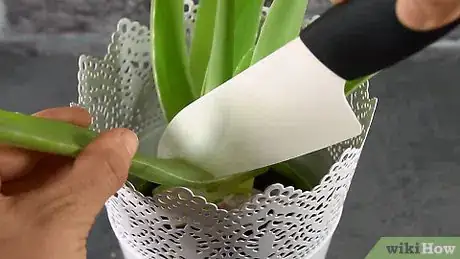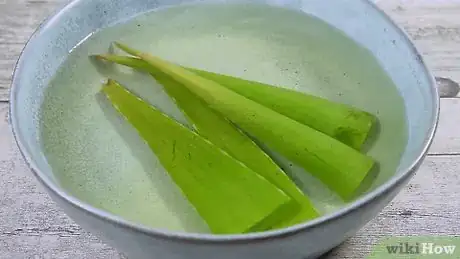This article was co-authored by wikiHow Staff. Our trained team of editors and researchers validate articles for accuracy and comprehensiveness. wikiHow's Content Management Team carefully monitors the work from our editorial staff to ensure that each article is backed by trusted research and meets our high quality standards.
There are 7 references cited in this article, which can be found at the bottom of the page.
The wikiHow Video Team also followed the article's instructions and verified that they work.
This article has been viewed 17,770 times.
Learn more...
Aloe vera is a succulent that’s loaded with a delicious and nutritious gel. You can actually cook and eat the gel, but the outer skin is tough and bitter. Luckily, the skin is super easy to remove so you can cook and eat the tasty raw aloe inside.
Steps
Removing the Peel
-
1Remove the stem by cutting it off at the base. If you’re harvesting your own aloe vera, choose large stems to extract the most raw aloe. Cut the stem at its base with a knife, right where it connects to the main part of the plant. Rinse any dirt off of the stem so it’s nice and clean.[1]
- If you’re harvesting from your own aloe plant, don’t cut away all of the stems or you could damage or potentially kill the plant.
- 2 large aloe vera stems can yield up to 1 pound (0.45 kg) of raw aloe.
-
2Cut off the first 1–2 centimetres (0.39–0.79 in) from the base of the stem. Use your knife and find a spot just above the base of the stem. Make a clean cut straight across to remove a small section. Cut away similarly sized sections from all of the aloe vera stems you’re using.[2]Advertisement
-
3Soak the raw aloe in water for 5 minutes to remove the alonin. Alonin is the yellow sap on the raw aloe gel. The alonin is a laxative that can upset your stomach, so fill a bucket or container with clean water and soak the stems in the water for 5 minutes to remove it.[3]
-
4Peel off the outer skin with a knife. Slide the sharp edge of your knife just under the outer peel of the aloe vera stem. Run the knife up the length of stem to peel away the outer layer of skin. Remove all of the green skin from each of the stems so you’re left with the raw aloe gel.[4]
- Your knife will glide easily through the aloe gel, so take your time and try to remove just the peel so you can keep as much raw aloe as possible.
-
5Pick off any bits of peel left on the aloe. The outer peel is bitter and tough, so remove all of it. Inspect the raw aloe gel after you peel the skin away and use your fingers to pick off any stubborn green bits left behind.[5]
Poaching the Aloe
-
1Chop up 1 pound (0.45 kg) of raw aloe into 1 inch (2.5 cm) cubes. Place the raw aloe on a cutting board. Use a sharp knife to slice the aloe gel into small, even cubes.[6]
-
2Add the aloe into a saucepan with 2 tablespoons (30 mL) of lime juice. Place the cubes of aloe into a medium-sized saucepan. Pour in the lime juice and swirl the pan around to mix them together.[7]
- Raw aloe can be super slippery and difficult to grip, so you may want to use a spoon to scoop it up.
-
3Stir in 1 cup (240 mL) of cane sugar into the pan. Add the sugar into the pan with the lime juice and aloe and use a spoon to stir it around. Stir the mixture well so it’s fully combined and will cook evenly.[8]
- If you don’t have cane sugar, you can use refined sugar.
-
4Cook the aloe over medium-low heat until it’s no longer slimy. Put the saucepan on a burner on your stovetop and set the temperature to medium-low so it doesn’t burn the aloe. Stir the aloe occasionally so it doesn’t stick to the saucepan. When the raw aloe slightly solidifies and isn’t slimy, remove the saucepan from the heat.[9]
-
5Serve the poached aloe over yogurt or jello for a light dessert. If you want a sweet aloe treat, fill a bowl with yogurt or jello. Top it off with your poached aloe and enjoy![10]
-
6Mix poached aloe vera into a soup for a savory option. Because aloe doesn’t have a strong flavor, you can use it to add substance to your soups and stews. Season the aloe with savory spices instead of sugar before you poach it. Then, spoon the aloe into a soup or stew as it cooks and enjoy it when it’s finished.[11]
Warnings
- Raw aloe can cause diarrhea if you have too much of it.⧼thumbs_response⧽
References
- ↑ https://youtu.be/gad-Nd6cFEw?t=43
- ↑ https://youtu.be/cT4vWCMYvF0?t=8
- ↑ https://youtu.be/TkGM_xTR8rI?t=132
- ↑ https://youtu.be/gad-Nd6cFEw?t=122
- ↑ https://youtu.be/cT4vWCMYvF0?t=125
- ↑ https://www.capitalfm.co.ke/lifestyle/2012/04/11/dont-just-drink-aloe-vera-cook-it/
- ↑ https://norecipes.com/poached-aloe-recipe/
- ↑ https://norecipes.com/poached-aloe-recipe/
- ↑ https://norecipes.com/poached-aloe-recipe/
























































